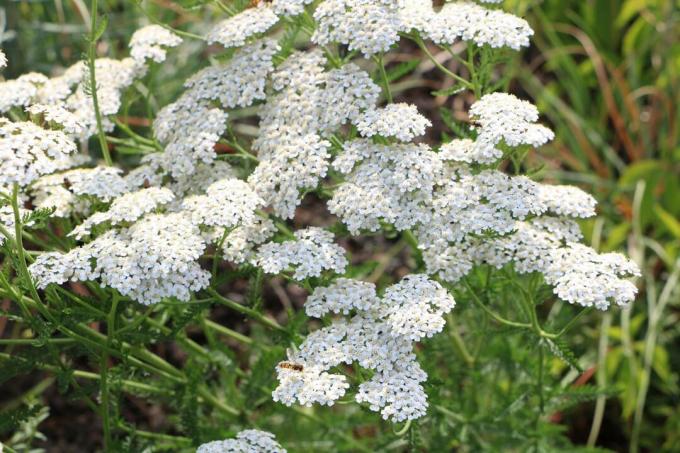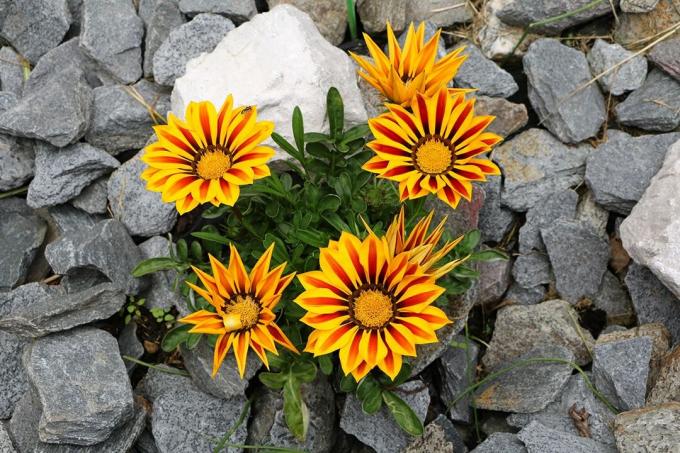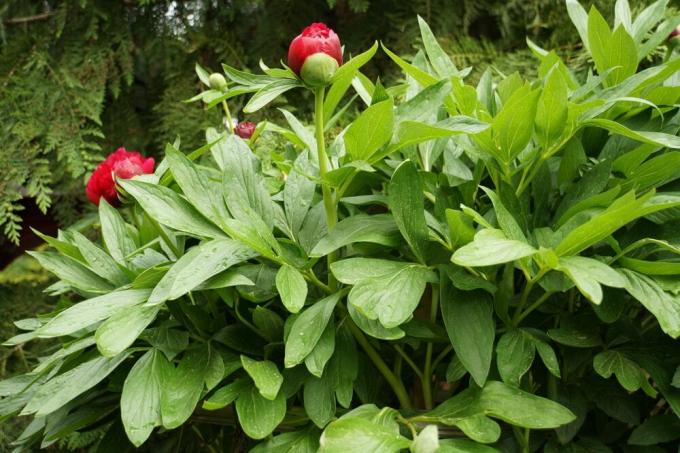

Table of contents
- Asters (Aster)
- Blue catnip (Nepeta x faassenii)
- Lady's Mantle (Alchemilla)
- Common yarrow (Achillea millefolium)
- Goldenrod (Solidago)
- Great masterwort (Astrantia major)
- Indian nettle (Monarda didyma)
- Jacob's Ladder (Polemonium caeruleum)
- Clustered Bellflower (Campanula glomerata)
- Blanket flower (Gaillardia x grandiflora)
- Globe thistle (Echinops ritro)
- Maideneye (Coreopsis)
- Musk mallow (Malva moschata)
- Magnificent stonecrop (Sedum spectabile)
- Purple Coneflower (Echinacea purpurea)
- Larkspur (Delphinium)
- Sunbride (Helenium)
More and more hobby gardeners are making their gardens bee-friendly in order to offer the little bees rich sources of food. It doesn't take a lot of resources to do that. Below we give you some tips for planting.
Asters (Aster)
growth height: 5cm to 300cm
growth width: 20 to 90 cm
blossom
- Flower head consisting of long ray and ray florets
- in the middle small, yellow tubular flowers
- Ray florets projecting horizontally from tubular florets
- usually form a single-row sometimes also multi-row wreath
- Diameter flower head 2 to 5 cm
- Flowers terminal on slightly hairy stems
- occurring singly or in groups
- Color white, purple, red, pink and shades of blue
growth
- herbaceous growing
- upright either branched or unbranched stems
- creeping rhizomes
- green ovate to lanceolate leaves
- alternate on the stem
- often forming a rosette of leaves at the bottom
- Leaves either stalked or sessile
- smooth or hairy
- serrated or smooth leaf margin
- leaves turn brown-grey in autumn
heyday: May to November

Location: sunny to semi-shady
Floor
- fresh
- permeable
- rich in nutrients and humus
- normal garden soil is sufficient
Blue catnip (Nepeta x faassenii)
growth height: 30 to 60 cm
growth width: 20 to 30 cm
blossom
- Flower color violet to blue
- lip-shaped, small flowers in spikes together
- strongly scented
growth
- loose and bushy
- forming clumps
- grey-green, fragrant, oval-heart-shaped leaves
- Leaf margin serrated

heyday: May to September
Location: sunny
Floor
- pH neutral to slightly acidic
- dry to fresh
- sandy to loamy
- well drained, moderately nutritious, mineral
Tip:
Catnip is the perfect companion for roses.
Lady's Mantle (Alchemilla)
growth height: 10 to 60 cm
growth width: 30 to 50 cm
blossom
- yellow-green, small single flowers
- clustered together on hairy shoots
growth
- lush growing
- woody rhizomes
- round to kidney-shaped, yellowish-green leaves
- palmately divided, fissured or lobed
- partly hairy
- serrated or serrated leaf margin
heyday
- June to July
- sometimes even into October
Location: sunny to semi-shady

Floor
- nutritious
- permeable
- fresh to moderately moist
- problem-free even on drier soils
- loamy to sandy
Tip:
Cutting back close to the ground immediately after flowering encourages new growth.
Common yarrow (Achillea millefolium)
growth height: 20 to 80 cm
growth width: 40 to 50 cm
Blossom: white, fragrant false umbel
growth
- prostrate to stiffly erect
- forms foothills
- soft, pinnate leaves
- fragrant and dark green
heyday: July to September

Location: sunny
Floor
- fresh to moist
- permeable
- rich in humus
- neutral to acidic
Tip:
To prevent the plant from aging, it should be divided after four to five years.
Goldenrod (Solidago)
growth height: 50 to 120 cm
growth width: 55 to 60 cm
blossom
- golden flower heads
- together in panicles
- Panicle branches slightly curved
growth
- compact and upright
- leafy stems
- forms clumps
- smooth, deep green, lanceolate leaves
- entire to serrated leaf margin
- tapered at the end
- Leaves alternate
heyday: July to September

Location: sunny
Floor
- permeable and fresh
- rich in humus
- sandy to loamy
A notice:
The goldenrod tends to self-seed, so it should be cut back immediately after flowering. In addition, the flowers have a honey-like taste and are ideal for making syrup.
Great masterwort (Astrantia major)
growth height: 50 to 70 cm
growth width: 40 to 50 cm
blossom
- simple, terminal umbel flowers
- Colors green, red, white
- greenish bracts
growth
- bushy
- upright flower stalks
- forms clumps
- glossy green, palmately lobed leaves
- sawn leaf edge
heyday: June to August

Location: sunny to semi-shady
Floor
- fresh to moderately moist
- rich in humus and nutrients
- permeable
- loamy to sandy
- pH neutral
- Plant loves lime
Indian nettle (Monarda didyma)
growth height: 80 to 150 cm
growth width: 50 to 70 cm
blossom
- Flower color dark to light red
- ball shaped
- reddish bracts
- pleasant smell
growth
- bushy, upright growing
- forms foothills
- lanceolate, pointed leaves
- Underside softly hairy
- Leaf edge sawn
- deep green and fragrant
- square stems
heyday: June to August

Location: sunny to slightly semi-shady
Floor
- permeable garden soil
- fresh and nutritious
- neutral area
Tip:
The Indian nettle is also suitable for keeping in buckets. The leaves and flowers are edible. They are used to make tea and spices and in medicine.
Jacob's Ladder (Polemonium caeruleum)
growth height: 60 to 70 cm
growth width: 40 to 50 cm
blossom
- small, cupped, blue flowers
- together in dense flower panicles
- long yellow to orange stamens
growth
- upright
- forming clumps
- alternate, green, soft leaves
- pinnate-elongated and entire
heyday: June to July

Location
- prefers partial shade
- sunny also possible
Floor
- fresh to moist
- permeable
- rich in humus and nutrients
- sandy to loamy
- slightly acidic to slightly alkaline
Clustered Bellflower (Campanula glomerata)
growth height: 50 to 60 cm
growth width: 25 to 30 cm
blossom
- terminal, small, bell-shaped flowers
- together in clusters
- Color blue to dark violet
- there is also a white breeding form
growth
- erect stems
- basal tuft of leaves
- foothills
- lanceolate, rough, green-red leaves
- finely hairy
- Leaf margin slightly serrated
heyday: June to August

Location: sunny to semi-shady
Floor
- fresh to moderately moist
- permeable
- rich in humus and nutrients
- loamy to gravelly
- pH alkaline
- Plant loves lime
Blanket flower (Gaillardia x grandiflora)
growth height: 10 to 75 cm
growth width: 20 to 30 cm
blossom
- terminal single flower
- radial shape
- hemispherically convex, brown center of the flower
- Flower color red with yellow edge
growth
- compact, dense and bushy
- upright flower stalks
- Leaves lanceolate, rounded at the tip
- dark green in color and finely hairy
- entire
heyday: July to October

Location: sunny
Floor
- fresh to moderately dry
- permeable
- rich in nutrients and humus
- pebbly to sandy
- slightly acidic to slightly alkaline
- Plant tolerates lime
Tip:
In severe frosts, the root area should be covered with fleece, leaves or brushwood
Globe thistle (Echinops ritro)
growth height: 60 to 100 cm
growth width: 60 to 80 cm
blossom
- spherical buds with a diameter of 2 to 4 cm
- Ball-shaped, light to violet-blue flowers
- Development of a beautiful seed head after flowering
growth
- loose, upright
- forming clumps
- basal tuft of leaves
- dull, grey-green, coarse leaves
- pinnate
- Leaf margin sinuate
heyday: July to September

Location: sunny
Floor
- dry to moderately moist
- permeable
- moderately rich in nutrients and humus
- gritty to loamy
- pH neutral
- Plant tolerates lime
A notice:
The globe thistle tends to self-seed. A pruning in autumn is advisable.
Maideneye (Coreopsis)
growth height: 10 to 180cm
growth width: 30 to 50 cm
blossom
- numerous radiating flowers
- yellow with a dark center
- there are also colored cultivated forms
growth
- compact, upright and bushy
- forming clumps
- pinnate, smooth, narrow, green leaves
- entire
heyday: June to October

Location: sunny
Floor
- loose earth
- rich in humus and nutrients
- permeable
Tip:
Pruning back in late fall will ensure a lush bloom the following year
Musk mallow (Malva moschata)
growth height: 50 to 60 cm
growth width: 55 to 60 cm
blossom
- soft pink
- cupped
- pleasantly scented
growth
- bushy, upright
- forming clumps
- filigree stems
- delicate, narrow, green leaves
heyday: June to September

Location: full sun
Floor
- dry to fresh
- permeable
- rich in humus and nutrients
- loamy to sandy
A notice:
Musk mallow is a well-known medicinal plant for respiratory and urinary tract infections. The flowers are edible.
Magnificent stonecrop (Sedum spectabile)
growth height: 40 to 50 cm
growth width: 40 to 50 cm
blossom
- star-shaped, small flowers
- arranged in umbels
- Umbels larger than 10 cm
- Flower color dark red to crimson
growth
- bushy with erect flower stalks
- forming clumps
- tough, succulent, oval leaves
- Leaf margin sinuate
heyday: August to September/October

Location: full sun
Floor
- dry to fresh
- permeable
- normal garden soil
A notice:
After the flowers have faded, a beautiful infructescence forms. This stays on the bed for a long time.
Purple Coneflower (Echinacea purpurea)
growth height: 80 to 100 cm
growth width: 40 to 50 cm
blossom
- radiating inflorescences
- purplish pink and slightly fragrant
- domed, brown-red flower center
- Flower head larger than 10 cm
- initially ray florets standing horizontally
- later slightly hanging down
growth
- upright and bushy
- forming clumps
- leafy stems
- tough, rough, dark green, lanceolate leaves
- entire
heyday: July to September

Location: sunny to slightly semi-shady
Floor
- permeable
- fresh to moderately dry
- rich in nutrients and humus
- sandy to loamy
- slightly acidic to alkaline
- Plant tolerates lime
A notice:
The coneflower is a proven medicinal plant.
Larkspur (Delphinium)
growth height: 150 to 180 cm
growth width: 70 to 80 cm
blossom
- small, semi-double flowers with a white center
- together in panicles
- backward pointing spur on the back of the flower
- Colors light to dark blue, white, violet
growth
- upright
- forming clumps
- Flower stalks leafy
- dull green, deeply dissected, palmate leaves
- lobed leaf margin
heyday: June to September

Location: sunny with low underplanting
Floor
- fresh to slightly moist
- permeable
- rich in humus and nutrients
- loamy
A notice:
Toxic alkaloids are contained in all parts of the plant, mainly the seed. In order to obtain a second bloom, a handbreadth above the ground is cut back after the main bloom.
Sunbride (Helenium)
growth height: 60 to 160 cm
growth width: up to 80 cm
blossom
- one or more flower heads per stem
- spherical to hemispherical in shape
- in the middle small, brown flowers
- all around wheel-shaped arrangement of ray florets
- Petals fused into a tube
- Color from yellow to orange to copper red
growth
- upright, bushy
- forming clumps
- erect stems
- alternate, dark green leaves
- Shape oval to lanceolate or pinnate
- Leaf margin serrated
heyday: June to October

Location
- sunny and sheltered from the wind
- the sunnier, the brighter the flowers
- light penumbra for plants with dark flowers
Floor
- fresh to moist
- rich in nutrients and humus
- loamy preferred
- slightly acidic to slightly alkaline
- Plant tolerates lime
Tip:
To strengthen the growth potential, a radical pruning should be carried out in the first year immediately after flowering.
 Home editorial office
Home editorial office
Learn more about flowers

Midday gold, Gazania: proper care and wintering
The midday gold, which impresses with its colorful and sun-loving flowers, is one of the most popular perennials for local gardeners. The right tips for caring for and overwintering the Gazania have been put together for you here.

Caring for, overwintering and cutting asters | Instructions
The radiant flowers of the asters enchant every garden as well as in pots, terraces and balconies, depending on the variety, from May until well into autumn. Caring for the perennials is not that difficult if everything is known about wintering and cutting.

Magnificent pier, Astilbe: care instructions from A - Z
Astilbe is very popular in the garden. Still, gardeners need to consider a few things if they want the plants to thrive. In our A-Z care instructions, you will learn everything you need to know about the splendor, from flowering to winter protection.

California Poppy, Eschscholzia californica: Care Instructions
Hardly any garden plant is as easy to care for as Californian poppy (Eschscholzia californica), which, with its golden yellow flowers, is a feast for the eyes in the home garden. In order to ensure the bright sea of flowers, a few points should be considered with regard to care.

When do peonies bloom? | Beginning and duration of the flowering period
Peonies are garden perennials that, after a few years, form a veritable sea of flowers in early summer. The individual flowers are long-lasting and are also suitable for cutting. Depending on the variety, they bloom in different colors. But when exactly is the heyday?

Goldtaler plant: care of Pallenis maritima | Is the flower hardy?
The Goldtaler plant is an easy-care balcony plant that impresses with its bright yellow flowers. Although it is often only cultivated as an annual in this country, the perennial plant can also be overwintered without major problems.
